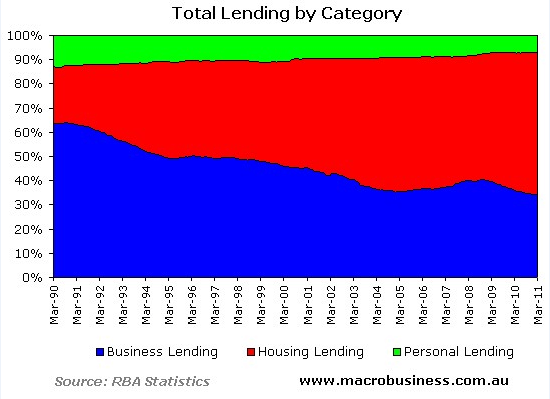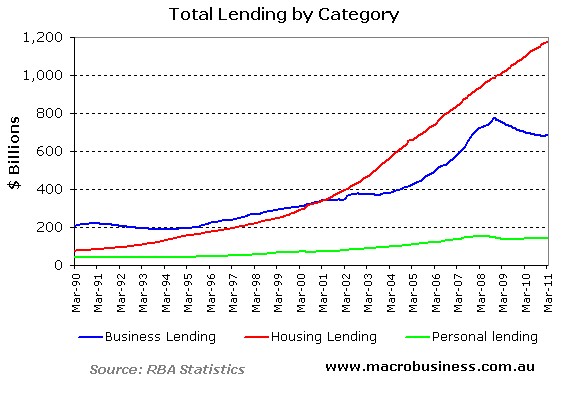
It takes courage and conviction to speak-out against the interests that employ you. Doing so can cause ridicule from peers and risks damaging one’s career prospects. So when Joseph Healy, business banking head of National Australia Bank (NAB), last year spoke-out against the Australian banks’ bias toward housing lending, I was suitably impressed.
Here’s an extract of what Mr Healy said back in July last year:
Australian banks’ preference for writing home loans rather than lending to business may pose a risk to the banking system and the overall economy, according to a leading banker.
Joseph Healy, business banking head of National Australia Bank, said the bias of banks toward retail mortgage lending could hobble the economy’s long-term growth by skimping on loans to small businesses. The money flowing into housing may create other distortions such as fuelling excessive investment, he said.
”With the apparent bias towards to the household sector, we shouldn’t discard the possibility of asset bubbles being created there,” Mr Healy said.
”We’re not saying we believe there is an asset bubble but shouldn’t close our minds to the possibility of that happening”…
Mr Healy said banks’ tilt towards home loans meant fewer loans are available for business, effectively crimping the economy’s growth engine.
”This is ultimately bad for growth, bad for competition, bad for jobs, bad for business and in the end bad for Australia,” he said.
The Australian economy’s over reliance on the housing market in place of productive investment is a key theme of this blog.
At the same time as the banks have actively financed the Australian housing bubble, the engine room and key employer of the Australian economy – small-to-medium enterprises (SME’s) – has been left languishing. The long-term impacts on the Australian economy from the banks’ focus on housing could be detrimental. Not only is Australia’s longer term growth potential being compromised, but our economic base is becoming increasingly concentrated on the resources sector and leveraged to the China growth story.
Further, because our debts are being increasingly accumulated in unproductive assets (mostly housing), the Australian economy is more vulnerable to external shocks than would have been the case had we channeled more of our loan capital towards entrepreneurial pursuits.
The folly of having so much lending directed towards housing was encapsulated beautifully yesterday by ICAP Australia’s senior economist, Adam Carr, in Business Spectator:
We’re not going to be seeing double digit house price growth for a while I suspect and that’s a good thing. At the end of the day, there is just no point to it. So house prices go up, the debt burden goes up and so the cycle goes – this may work well for some individuals, but for the economy as a whole it is a pointless exercise. It’s not like we’re enhancing the wealth of the nation or expanding the productive capacity of the economy with all this borrowing though. It’s not like we were even building a lot of houses when there was strong house price growth. We’re just borrowing money, generally from overseas, to push house prices higher – which is insane.
Last week, NAB’s Joseph Healy expanded on last year’s comments in a speech to the Dun & Bradstreet Giving Small Business Credit Conference (hat tip Gotti). In this speech, Mr Healy stressed the importance of fostering SMEs in order to diversify Australia’s economic base and to ward against Dutch Disease.
On the economic importance of SMEs, here are some facts: SMEs are the largest employers and the largest contributors to GDP. The small business sector generates around 34 per cent of private industry value added and 48 per cent of private sector employment. Ninety-eight percent of all businesses in Australia are SMEs and they provide private sector jobs for nearly 4.8 million Australians…
The immediate risk is that we become complacent to the fact that whilst we have strong macro-economic headlines, underpinned by concentration risk on China and the booming resources sector, at some stage all prudent managers and policy makers thinking about the future need to ensure that we address the risk of our economy being so heavily concentrated or undiversified…
Mr Healy again warned that SME’s are finding it overly difficult to obtain financing from Australia’s banks due to their over-emphasis on housing lending. And this diversion of funding away from SME’s is inhibiting their growth potential.
Financing the productive capacity of the economy is critical to long term economic success. While large businesses have various options open to them, including the capital markets, SMEs are heavily dependant on the banking system…
What… became apparent during the GFC, was evidence of a bias in our banking system towards home lending… Since 2000, Australian home lending grew from approx $280bn to over $1.2tn today. In 2000, every $1000 of home lending was matched roughly by equivalent business lending – by 2010 for every $1000 home lending, there was only around $600 of business lending…
We mustn’t lose sight of the fact that the efficient capital allocation by the banking system is important to long term growth of the economy and any bias can be harmful in crowding out lending to other sectors ie a bias to home lending could mean there is less capital to allocate to businesses, the most productive area of the economy – this could be bad for growth, competition, jobs and in the end bad for Australia.
The structural shift by the banks toward housing lending is even more pronounced if we go back to 1990 – the beginning of the RBA data series. In 1990, business lending comprised nearly two-thirds of total lending, with housing lending and personal lending making up the difference. In 2011, however, business’ share of total lending has fallen to around one-third, swallowed up by housing lending (see below chart).

The growth of housing lending relative to business lending is just as pronounced when total loan values are shown instead:

In what should be familiar to regular readers of Deep T., Mr Healy blames the Basel II capital adequacy rules for providing banks with an incentive to concentrate their lending on housing [my emphasis].
The Basel II rules created an incentive for banks to favour residential mortgage lending relative to business lending as mortgages attract a lower capital charge. On average banks can do 3-4 times more mortgage lending relative to business lending in terms of capital management. This is important as one of the primary measures of success in banking (as in most businesses) is the return on equity (RoE) that a bank can earn – the less capital involved, all other things being equal, the higher the RoE.
But incentives to focus on RoE, whilst perfectly rational for individual banks, can create outcomes that may not be rational for the wider economy; in other words rationally irrational! Thus today, we have a system that makes it more attractive for banks to lend the marginal dollar on a weekend holiday home than to a small business – arguably a perverse outcome and one difficult to reconcile with the traditional role and societal expectation of banks in recycling savings by lending to encourage productive investment and economic growth (we saw in other markets, the risk of distorted incentives in creating asset bubbles). As one leading economic commentator said: “Unfortunately, there is nothing in a typical banker’s employment contract that says he should take into account the impact of his actions on the economy as a whole”.
The amount of capital a bank allocates against its lending is determined by the risk-weighting of the lending. Based on historical data models, home lending has had the lowest risk compared to business lending, and within business lending, the risk is greater when lending to SME’s versus large investment grade corporates. Tools banks use to measure these risks and risk weightings, include looking at the historical probability of default (PD) and the likely loss given default (LGD).
Australia is fortunate to have a senior banker, like Mr Healy, standing up for the national interest. Let’s hope that policy makers in Canberra and the Government are listening.
Cheers Leith

